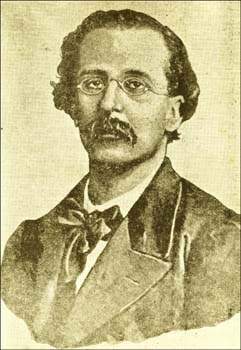Juan Clemente Zenea facts for kids
Quick facts for kids
Juan Clemente Zenea
|
|
|---|---|
 |
|
| Born | February 24, 1832 Bayamo, Cuba
|
| Died | 1871 (age 38) |
| Nationality | Cuban |
| Occupation | Poet |
| Years active | 1846–1871 |
| Style | Romanticism |
Juan Clemente Zenea was an important Cuban writer and poet. He was born in Bayamo, Granma, on February 24, 1832. Zenea is known for bringing back a style of writing called Romanticism to Cuban literature. This style focuses on strong emotions, nature, and individual experiences. His work helped start a new era for poetry in Cuba and other Spanish-speaking countries.
Contents
Early Life and First Writings
Juan Clemente Zenea began his education in 1845. He attended a college run by José de la Luz y Caballero. It was here that he first showed a strong interest in literature.
In 1846, Zenea's first poems were published. They appeared in "La Prensa," a newspaper in Havana. By 1849, he became a writer for this newspaper.
Growing as a Writer
After joining "La Prensa," Zenea's writing career grew quickly. He wrote many works, sometimes with other authors. For example, he worked with José Fornaris and Rafael Otero on a piece called “La mujer ¿Es un ángel? ¡No es un ángel! ¿Si será o no será?”. He also wrote "Almendares" with Idelfonso Estrada Zenea.
Life in Exile and Return
In 1852, Zenea had to leave Cuba. He moved to New Orleans, USA. While there, he wrote for several newspapers. These included "El correo de Louisiana," "El Independiente," and "Faro de Cuba." He used his writing to speak out against the Spanish government.
Later, he moved to New York. There, he continued to write for publications like "El Filibustero," "La Verdad," and "El Cubano." Because of his activities against the Spanish government, he was sentenced to death in Havana in 1853. However, he was later pardoned, meaning he was forgiven.
Back in Cuba
Zenea was able to return to Cuba in 1854. After his return, he worked as an English teacher. He taught at José de la Luz y Caballero's college, the same place where he had studied.
During this time, Zenea produced many different works. He also received several awards for his writing. Some of his poems were included in a collection called "El laúd del desterrado." Many of his articles appeared in Cuban and Spanish magazines. He also started and managed his own magazine, the "Revista Habanera."
Fight for Cuban Freedom
In 1865, Zenea went back to New York. He worked for the "Revista del Nuevo Mundo." Then, he moved to Mexico to write for the "Diario Oficial."
When the war for Cuban independence began in 1868, Zenea returned to the United States. He wanted to help the cause for Cuba's freedom. He tried to join several expeditions to Cuba, but they all failed.
Final Years and Legacy
In 1870, Zenea managed to secretly reach Cuba. He met with Carlos Manuel de Céspedes, a leader of the Cuban rebellion. While trying to return to the United States, Spanish troops captured him. Juan Clemente Zenea was shot to death in 1871, at the age of 38.
His dedication to both literature and his country's freedom made him a lasting figure in Cuban history.
Published Works
- 1855 Poesías
- 1859 Lejos de la patria. Memorias de un joven poeta
- 1860 Cantos de la tarde
- 1861 Sobre la literatura de Estados Unidos
Well-Known Poems
- En un álbum
- Fidelia
- A una golondrina
- Diario de un mártir
- Ausencia
- En Greenwood
- Nocturno
- Las sombras
- Retorno
- Oriente y Ocaso
See also
 In Spanish: Juan Clemente Zenea para niños
In Spanish: Juan Clemente Zenea para niños


